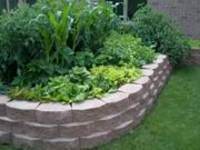Article by Paul Stone.
This form of gardening has additional benefits to those of traditional gardening. Handicapped and elderly gardeners for instance, can gain access to their plants much easier. Most raised beds are no more than 4 feet wide, this makes the plants easily reachable. But the beds can be designed any height, width and shape to suit the individual who is going to use them.
The soil that the plants are grown in can be improved more easily. If you live in an area that has very sandy or heavy clay soils it can be a constant struggle to get your plants to flourish. With raised beds you can import a quality soil from elsewhere, or fill them with a proprietary compost brand.
Raised beds are also very productive for food crops. By using a raised bed you could double or even triple the harvested crop, than you would get from the same space in a conventional garden. As everything is within easy reach, you can divide up the beds into grids and plant a specific plant type in each grid section. This allows you to make maximum use of every inch of the bed.
Weeds are less of a problem in raised beds than they are in normal gardens. Any weeds that do germinate are more easily spotted and removed. As everything is within easy reach, your soil won’t become compacted due to you walking on it to remove weeds and perform other tasks.
Watering is also a lot easier, and as you have a smaller area to cover. You won't waste water on paths between your crops or flowers that have nothing growing in them. You could also quite easily set-up a drip irrigation system that will deliver a slow stream of water throughout the day.
Pest control can also be a lot easier with raised beds. The base can be covered with a poultry wire to prevent burrowing animals ruining your plants. Low fences can also be placed around the top of the beds to prevent animals from hoping up on to them.
It doesn't matter what sort of plant you want to grow, as raised beds are suitable for all types of plants. As raised beds aren't reliant on the soil in your area you can create beds for any type of plant by using filling them with different soil variations. You could create one bed for alpines, line another with a pond liner or waterproofing compound and grow bog plants, and have another for vegetables.
Raised beds can look extremely attractive as well as being productive, and can be used to create focal points in the garden if executed well.










Worser - 17 years ago
Further to Jantu’s comment regarding raised garden beds. Because of bending problems and always having a big vege garden for as long as I can remember, I ‘designed’ a raised garden. Each bed consisted of 3 sheets of 2nd hand corrugated iron. 1 for each side and the other cut in half for the ends. Secured by fence posts at ends and side. Filled with good topsoil, compost and horse manure. These have been in place since August 08 and have produced great veges (earlier than before) Possibly because they warm up quicker. However the down side is they watering needs to be closely watched as they dry out quicker too.
Worked out fairly inexpensive, about $80 for 2 beds.